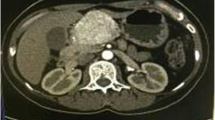Abstract
Background
Subdiaphragmatic paraganglioma is a rare neuroendocrine tumor for which scarce data exist regarding long-term patient outcome following resection. The aim of this study was to determine the association of surgical resection with survival.
Methods
A retrospective study at a tertiary care center was performed. Demographics, genetics, histology, and operative details were reviewed. Patients were grouped according to margin status (R0, R1, or R2) and survival calculated.
Results
A total of 50 patients with subdiaphragmatic paragangliomas underwent primary resection from 1999 to 2012. Median age at operation was 46 years, with a median tumor size of 6.0 cm. Of these patients, 30 (60 %) had a R0 resection, 11 (22 %) had a R1 resection, and 9 (18 %) had a R2 resection. There was no operative mortality, and 17 (34 %) patients had metastatic disease. Six (12 %) patients died, four (8 %) of whom had metastatic disease. Univariate analysis identified that age >50 years (p = 0.02) and undergoing a R2 resection (p = 0.03) were associated with a shorter overall survival (OS). Those with metastases at some point after their initial diagnosis had a shorter disease-free survival (DFS) than those without metastases (p = 0.04). Of 27 patients tested, 12 (44 %) had a germline succinyl dehydrogenase B (SDHB) mutation. SDHB immunohistochemistry identified 18 patients (of 27 who underwent staining) who had loss of SDHB expression in which 7 of 11 patients (63 %) who underwent genetic testing had a genetic mutation.
Conclusions
Surgical resection of subdiaphragmatic paraganglioma is safe. Survival was longest in patients who were younger, with no metastases, or had a R0 or R1 resection. Patients who test negative for a germline mutation should undergo SDHB immunostaining to identify potential hereditary carriers missed by current genetic testing.






Similar content being viewed by others
References
Joynt KE, Moslehi JJ, Baughman KL (2009) Paragangliomas: etiology, presentation, and management. Cardiol Rev 17(4):159–164
Laird AM et al (2012) Paraganglioma: not just an extra-adrenal pheochromocytoma. Langenbeck’s Arch Surg 397(2):247–253
Lee JA, Duh QY (2008) Sporadic paraganglioma. World J Surg 32(5):683–687. doi:10.1007/s00268-007-9360-4
Chen H et al (2010) The North American Neuroendocrine Tumor Society consensus guideline for the diagnosis and management of neuroendocrine tumors: pheochromocytoma, paraganglioma, and medullary thyroid cancer. Pancreas 39(6):775–783
DeLellis RA (2004) Pathology and genetics of tumours of endocrine organs. World Health Organization classification of tumours. IARC Press, Lyon, p 320
Ayala-Ramirez M et al (2011) Clinical risk factors for malignancy and overall survival in patients with pheochromocytomas and sympathetic paragangliomas: primary tumor size and primary tumor location as prognostic indicators. J Clin Endocrinol Metab 96(3):717–725
Fishbein L et al (2013) Inherited mutations in pheochromocytoma and paraganglioma: why all patients should be offered genetic testing. Ann Surg Oncol 20(5):1444–1450
Welander J, Soderkvist P, Gimm O (2011) Genetics and clinical characteristics of hereditary pheochromocytomas and paragangliomas. Endocr Relat Cancer 18(6):R253–R276
Schlisio S et al (2008) The kinesin KIF1Bbeta acts downstream from EglN3 to induce apoptosis and is a potential 1p36 tumor suppressor. Genes Dev 22(7):884–893
Yeh IT et al (2008) A germline mutation of the KIF1B beta gene on 1p36 in a family with neural and nonneural tumors. Hum Genet 124(3):279–285
Neumann HP et al (2002) Germ-line mutations in nonsyndromic pheochromocytoma. N Engl J Med 346(19):1459–1466
Neumann HP et al (2004) Distinct clinical features of paraganglioma syndromes associated with SDHB and SDHD gene mutations. JAMA 292(8):943–951
Pasini B et al (2008) Clinical and molecular genetics of patients with the Carney-Stratakis syndrome and germline mutations of the genes coding for the succinate dehydrogenase subunits SDHB, SDHC, and SDHD. Eur J Hum Genet 16(1):79–88
Young WF Jr (2010) Endocrine hypertension: then and now. Endocr Pract 16(5):888–902
van Nederveen FH et al (2009) An immunohistochemical procedure to detect patients with paraganglioma and phaeochromocytoma with germline SDHB, SDHC, or SDHD gene mutations: a retrospective and prospective analysis. Lancet Oncol 10(8):764–771
Korpershoek E et al (2011) SDHA immunohistochemistry detects germline SDHA gene mutations in apparently sporadic paragangliomas and pheochromocytomas. J Clin Endocrinol Metab 96(9):E1472–E1476
Ayala-Ramirez M et al (2013) Bone metastases and skeletal-related events in patients with malignant pheochromocytoma and sympathetic paraganglioma. J Clin Endocrinol Metab 98(4):1492–1497
Erickson D et al (2001) Benign paragangliomas: clinical presentation and treatment outcomes in 236 patients. J Clin Endocrinol Metab 86(11):5210–5216
Oltmann SC, Chen H (2013) Doing away with the rule of 10%. Ann Surg Oncol 20(5):1403–1404
Author information
Authors and Affiliations
Corresponding author
Rights and permissions
About this article
Cite this article
Abadin, S.S., Ayala-Ramirez, M., Jimenez, C. et al. Impact of Surgical Resection for Subdiaphragmatic Paragangliomas. World J Surg 38, 733–741 (2014). https://doi.org/10.1007/s00268-013-2443-5
Published:
Issue Date:
DOI: https://doi.org/10.1007/s00268-013-2443-5




